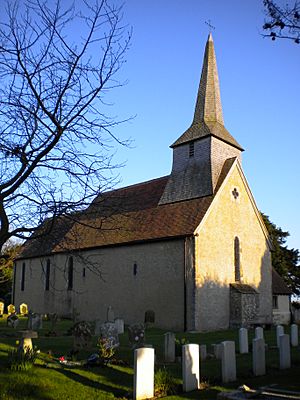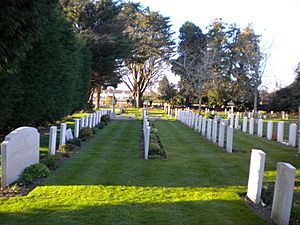St Andrew's Church, Tangmere facts for kids
Quick facts for kids St Andrew, Tangmere |
|
|---|---|
 |
|
| Denomination | Church of England |
| History | |
| Dedication | Saint Andrew |
| Administration | |
| Parish | Tangmere, St Andrew |
| Deanery | Chichester |
| Archdeaconry | Chichester |
| Diocese | Chichester |
| Province | Canterbury |
St Andrew's Church is a Church of England church building. It is located in the village of Tangmere, in West Sussex, England. The church is part of the Diocese of Chichester.
Contents
The History of St Andrew's Church
The village of Tangmere was first settled by the Anglo-Saxons. It is about a mile south of Stane Street, an old Roman road. This road once connected Londinium (London) with Noviomagus Reginorum (Chichester). However, St Andrew's Church was built after the Norman conquest of England in 1066.
Building the Church
The first church in Tangmere was made of timber (wood). In the 12th century, a new church was built using stone and timber. This new building had windows on its north and south sides. The bell tower sits on a wooden frame inside the main part of the church, called the nave.
The chancel, which is the area around the altar, and its arch were added in the 13th century. There is also a simple, round stone font used for baptisms. A very old yew tree stands near the church door. Its large size suggests that this spot has been a special or sacred place for a very long time.
A Royal Fair and a Lightning Strike
In 1341, King Edward II gave the new Archbishop of Canterbury permission to hold a fair in Tangmere. This fair was to be held on St Andrew's Day, which is November 30th. The church still holds a similar event every autumn today.
During World War II, the church was close to RAF Tangmere, an important air base. It survived many attacks by the German air force, the Luftwaffe. But in October 2003, a sudden lightning strike hit the church. It ripped the spire, damaged the roof, and caused a lot of destruction inside. While the church was being repaired, a special picture called Spirit of Tangmere was made. It showed a Supermarine Spitfire plane flying over the church as if it were landing.
Tangmere War Graves
From 1917, a field next to the church became a base for the Royal Flying Corps. This later became a Royal Air Force aerodrome (airfield). In 1939, before World War II, the airfield was made larger. This was to help defend the south coast of England from the Luftwaffe. The air base stayed open until 1966.
Because the church was so close to the RAF base, many service members who died there were buried in the church's graveyard. There are 39 graves from the 1939–1945 War for airmen from the Commonwealth of Nations. One of these airmen is unknown. There are also 13 graves for German airmen from the Luftwaffe, with one of them unidentified. Most of these airmen died during the Battle of Britain.
Today, the Commonwealth War Graves Commission takes care of all these graves. The Commonwealth war graves are in three rows on the western side of the church. The German graves are placed next to them.
Famous Pilot's Grave
Also in the churchyard is the grave of Air Commodore Edward "Teddy" Mortlock Donaldson. He was a famous RAF pilot during World War II. In 1946, he set a world record for air speed in a Gloster Meteor jet. He took off and landed from RAF Tangmere for this record-breaking flight.
A new window in St Andrew's Church is dedicated to the memory of all the men and women who gave their lives serving their country.
See also


